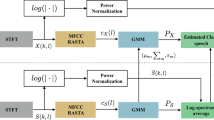Abstract
This paper describes an algorithm that enhances speech by independent vector analysis (IVA) using harmonic frequency dependency for robust speech recognition. While the conventional IVA exploits the full-band uniform dependencies of each source signal, a harmonic clique model is introduced to improve the enhancement performance by modeling strong dependencies among multiples of fundamental frequencies. An IVA-based learning algorithm is derived to consider the non-holonomic constraint and the minimal distortion principle to reduce the unavoidable distortion of IVA, and the minimum power distortionless response beamformer is used as a pre-processing step. In addition, the algorithm compares the log-spectral features of the enhanced speech and observed noisy speech to identify time–frequency segments corrupted by noise and restores those with the cluster-based missing feature reconstruction technique. Experimental results demonstrate that the proposed method enhances recognition performance significantly in noisy environments, especially with competing interference.



Similar content being viewed by others
References
Juang BH (1991) Speech recognition in adverse environments. Comput Speech Lang 5:279–294
Singh R, Stern RM, Raj B (2002) Model compensation and matched condition methods for robust speech recognition. In: Davis G (ed) Noise reduction in speech applications. CRC Press, Florida
Raj B, Parikh V, Stern RM (1997) The effects of background music on speech recognition accuracy. In: IEEE ICASSP, pp 851–854
Haykin S (2000) Unsupervised adaptive filtering, volume 1: blind source separation. Wiley, New York
Comon P, Jutten C (2010) Handbook of blind source separation: independent component analysis and applications. Academic Press, Oxford
Hyvärinen A, Harhunen J, Oja E (2001) Independent component analysis. Wiley, New York
Kim T, Attias HT, Lee S-Y, Lee T-W (2007) Blind source separation exploiting higher-order frequency dependencies. IEEE Trans Audio Speech Lang Process 15:70–79
Lee I, Jang G-J, Lee T-W (2009) Independent vector analysis using densities represented by chain-like overlapped cliques in graphical models for separation of convolutedly mixed signals. IET Elect Lett 45(13):710–711
Choi CH, Chang W, Lee S-Y (2012) Blind source separation of speech and music signals using harmonic frequency dependent independent vector analysis. IET Elect Lett 48(2):124–125
Matsuoka K, Nakashima S (2001) Minimal distortion principle for blind source separation. In: International workshop on ICA and BSS, pp. 722–727
Raj B, Seltzer ML, Stern RM (2004) Reconstruction of missing features for robust speech recognition. Speech Commun 43:275–296
Amari SI, Chen TP, Cichocki A (2000) Nonholonomic orthogonal learning algorithms for blind source separation, Neural computation 12(6). MIT Press Cambridge, MA
Kim L-H, Tashev I, Acero A (2010) Reverberated speech signal separation based on regularized subband feedforward ICA and instantaneous direction of arrival. In: IEEE ICASSP, pp 2678–2681
Raj B, Stern RM (2005) Missing-feature methods for robust automatic speech recognition. IEEE Signal Process Mag 22:101–116
Kim M, Kim J-S, Park H-M (2011) Robust speech recognition using missing feature theory and target speech enhancement based on degenerate unmixing and estimation technique. In: Proceedings of SPIE 8058, 80580D
Rabiner L, Juang BH (1993) Fundamentals of speech recognition. Prentice-Hall, New Jersey
Price P, Fisher WM, Bernstein J, Pallet DS (1988) The DARPA 1000-word resource management database for continuous speech recognition. In: Proceedings of IEEE ICASSP, pp 651–654
Young SJ, Evermann G, Gales M, Hain T, Kershaw D, Liu X, Moore G, Odell J, Ollason D, Povey D, Valtchev V, Woodland PC (2006) The HTK book (for HTK version 3.4). University of Cambridge, Cambridge
Allen JB, Berkley DA (1979) Image method for efficiently simulating small-room acoustics. J Acoust Soc Am 65(4):943–950
Acknowledgments
This work was supported by the Mid-career Researcher Program through the National Research Foundation of Korea (NRF) funded by the Ministry of Education, Science and Technology of Korea (No. 2011-0027537). We appreciate valuable comments and advice of Il-Young Jeong.
Author information
Authors and Affiliations
Corresponding author
Rights and permissions
About this article
Cite this article
Jun, S., Kim, M., Oh, M. et al. Robust speech recognition based on independent vector analysis using harmonic frequency dependency. Neural Comput & Applic 22, 1321–1327 (2013). https://doi.org/10.1007/s00521-012-1002-6
Received:
Accepted:
Published:
Issue Date:
DOI: https://doi.org/10.1007/s00521-012-1002-6




